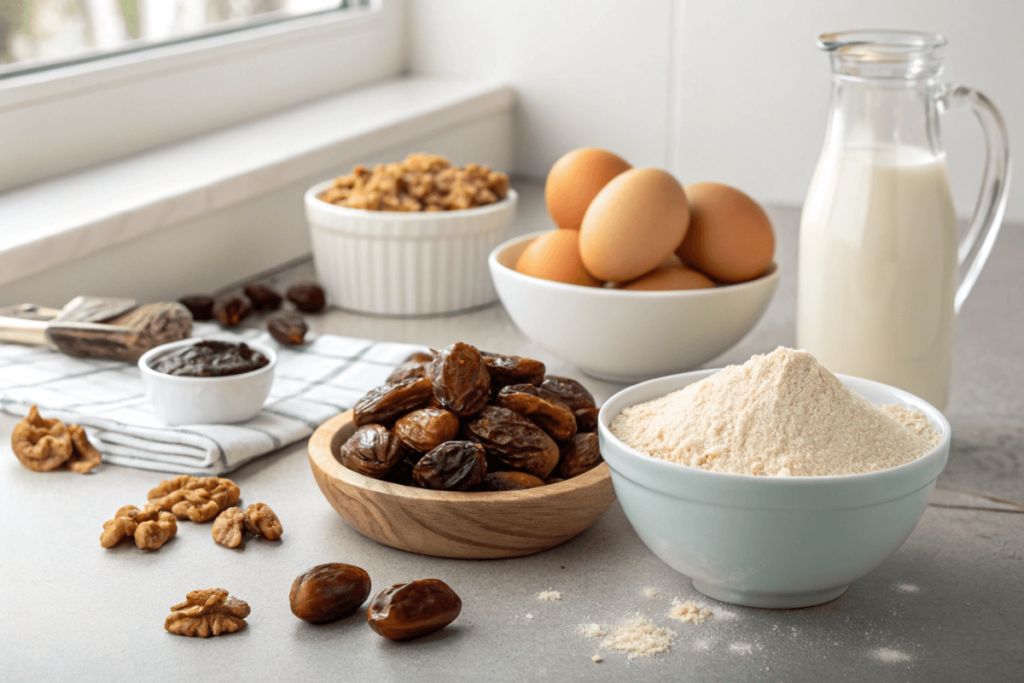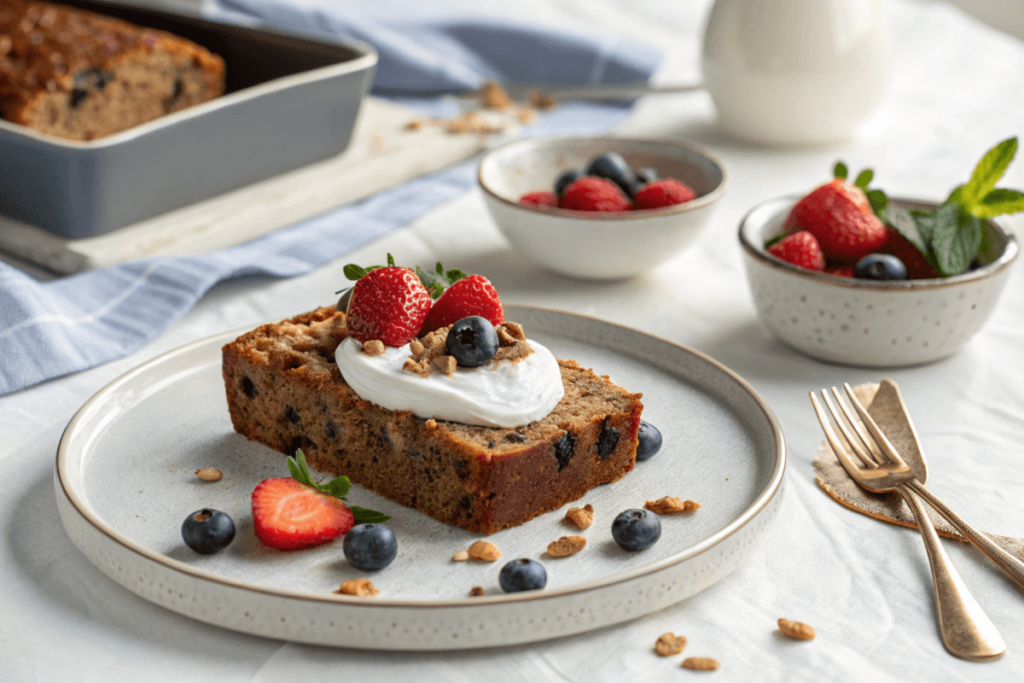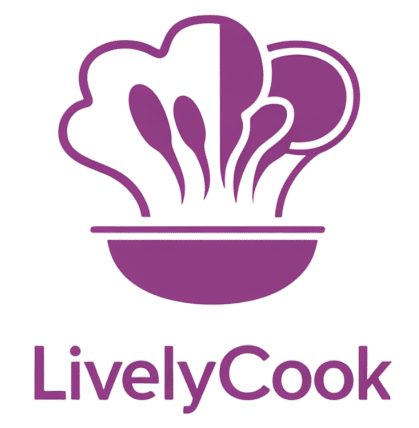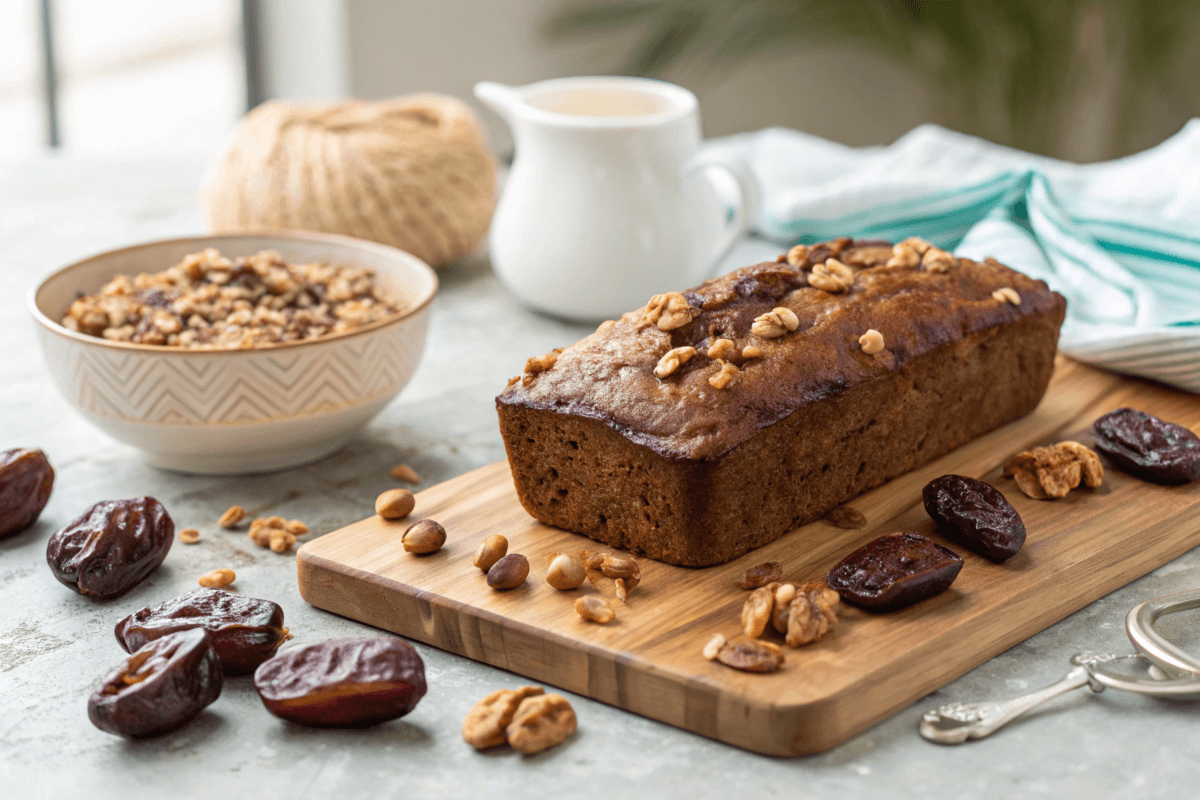Delicious, wholesome, and satisfying—date and nut loaf has been a favorite in many homes for years. But how many calories in a date and nut loaf does one slice contain? This classic baked treat combines the natural sweetness of dates with the crunchy goodness of nuts, making it both tasty and nutritious. Let’s find out if it can fit into a healthy diet.
This article looks at the nutritional benefits of date and nut loaf, its calorie content, and how it can support your health. We’ll also share recipe tips, answer common questions, and suggest creative ways to enjoy this beloved dessert.
Introduction to Date and Nut Loaf
What Makes Date and Nut Loaf Special?
A date and nut loaf isn’t just a dessert—it’s a warm, comforting treat that brings back memories. Made with dates, nuts, flour, and a hint of sweetness, this loaf blends indulgence with a touch of healthiness. Whether enjoyed as a snack or dessert, its versatility makes it a popular choice around the world.
The secret is in the ingredients. Dates add natural sweetness and a rich, caramel-like taste, while nuts add crunch and a warm, nutty flavor. Mixed with simple pantry staples, these ingredients create a soft, flavorful loaf that’s perfect for any moment.
Origins and Popularity Across Cultures
Date and nut loaf has a rich history, with its roots tracing back to traditional European baking. Over time, its popularity spread globally, adapting to local tastes. In the United Kingdom, it’s often enjoyed with tea, while in the Middle East, it highlights the abundance of dates in regional cuisine.
In modern times, health-conscious bakers have embraced this loaf for its blend of natural ingredients and nutrients, making it an ideal choice for those seeking a guilt-free indulgence.
Stay tuned as we explore the nutritional powerhouses behind this loaf and uncover its caloric details in the next section.
Nutritional Overview of Key Ingredients
Understanding the nutritional value of the main components in a date and nut loaf can shed light on its overall health benefits and calorie content.

Dates: Nutritional Profile and Health Benefits
Caloric Content of Dates
Dates are naturally sweet fruits that contribute significantly to the calorie content of a date and nut loaf. On average, a single Medjool date contains about 66 calories, primarily from natural sugars. This natural sweetness reduces the need for added sugars in recipes, making dates a healthier alternative for sweetening baked goods.
Vitamins and Minerals in Dates
Beyond their sweetness, dates are full of important nutrients. They are rich in fiber, potassium, magnesium, and vitamin B6. Potassium helps keep your heart healthy, and magnesium supports your muscles. Plus, the fiber in dates helps with digestion, keeping your gut healthy.
Health Benefits of Consuming Dates
Incorporating dates into your diet offers several health advantages. Their high antioxidant content helps combat oxidative stress, potentially reducing the risk of chronic diseases. Moreover, the natural sugars in dates provide a quick energy boost, making them an excellent choice for a pre-workout snack. The fiber content also aids in regulating blood sugar levels, despite their sweetness.
Nuts: Nutritional Profile and Health Benefits
Common Nuts Used in Loaves (e.g., Walnuts, Pecans)
Nuts like walnuts and pecans are popular choices in date and nut loaves, adding crunch and depth of flavor. Each type of nut brings its unique nutrient profile to the table.
Caloric Content of Nuts
Nuts are calorie-dense due to their healthy fat content. For instance, a one-ounce (28g) serving of walnuts contains approximately 185 calories, while the same amount of pecans has about 196 calories. These calories come from a mix of fats, proteins, and carbohydrates, contributing to the loaf’s overall energy content.
Vitamins and Minerals in Nuts
Walnuts are rich in omega-3 fatty acids, which are beneficial for heart health. They also provide manganese, copper, and biotin. Pecans offer a good amount of thiamin, zinc, and phosphorus. Both nuts are excellent sources of antioxidants, which help protect the body from oxidative damage.
Health Benefits of Consuming Nuts
Regular consumption of nuts has been linked to various health benefits, including improved heart health due to their healthy fat content. The combination of protein and fiber in nuts promotes satiety, potentially aiding in weight management. Additionally, nuts have anti-inflammatory properties and may help in reducing bad cholesterol levels.
Caloric Content of Date and Nut Loaf
When indulging in a slice of date and nut loaf, it’s essential to understand its caloric content, especially if you’re mindful of your daily calorie intake.
Average Calorie Count per Serving
Standard Serving Size Definition
A typical serving size for date and nut loaf is one slice, usually weighing around 60 grams. However, serving sizes can vary based on the recipe and personal preferences.
Calorie Range in Common Recipes
The calorie content of a date and nut loaf can vary depending on the ingredients and preparation methods. For example, one slice (60g) of date and walnut loaf contains approximately 207 calories.
Calorie King Another source indicates that a 2 oz (57g) serving of date nut loaf contains about 190 calories.
Eat This Much These variations highlight the importance of portion control and ingredient selection in managing calorie intake.
Factors Influencing Caloric Content
Variations in Ingredient Quantities
The amount of dates, nuts, and sweeteners used can significantly impact the loaf’s calorie content. Using more dates and nuts increases the calorie count due to their high natural sugar and fat content. Adjusting these quantities allows for customization of the loaf’s caloric density.
Types of Nuts and Their Impact on Calories
Different nuts have varying calorie contents. For instance, almonds have fewer calories per ounce compared to pecans. Choosing nuts with lower calorie counts can slightly reduce the overall caloric content of the loaf.
Additional Ingredients (e.g., Sugars, Fats) and Their Effects
Incorporating ingredients like butter, oil, or additional sweeteners can elevate the calorie content. Opting for healthier alternatives, such as unsweetened applesauce instead of oil or reducing added sugars, can make the loaf more calorie-friendly without compromising taste.
Comparative Analysis with Other Baked Goods
Date and Nut Loaf vs. Banana Bread
When comparing date and nut loaf to banana bread, the former often contains more natural sugars due to dates, potentially leading to a higher calorie count. However, banana bread recipes can also be calorie-dense, especially when made with added sugars and fats. Both can be enjoyed in moderation, with mindful attention to portion sizes.
Date and Nut Loaf vs. Fruitcake
Fruitcake is traditionally rich in candied fruits and nuts, making it calorie-dense. A slice of fruitcake can contain more calories than a slice of date and nut loaf, primarily due to the added sugars and syrups used in its preparation. Therefore, date and nut loaf may be a slightly lighter option compared to traditional fruitcake.
Understanding the caloric content and nutritional value of date and nut loaf allows you to enjoy this delightful treat while staying informed about your dietary choices.
Health Considerations and Dietary Impact
Enjoying a slice of date and nut loaf can be both delightful and nutritious. However, it’s essential to understand its health implications and how it fits into various dietary needs.
Incorporating Date and Nut Loaf into a Balanced Diet
Portion Control and Frequency
While date and nut loaf offers natural sweetness and beneficial nutrients, moderation is key. Consuming it in appropriate portions ensures you enjoy its flavors without overindulging. For instance, limiting yourself to one slice per serving can help manage calorie intake effectively.
Balancing Caloric Intake
Being mindful of the loaf’s calorie content is crucial, especially if you’re monitoring your daily caloric intake. Pairing a slice with a source of protein, such as yogurt or a handful of nuts, can create a more balanced snack, promoting satiety and preventing overeating.
Potential Health Benefits
Nutrient Density and Energy Provision
Dates and nuts are rich in essential vitamins and minerals. Dates provide natural sugars that offer a quick energy boost, while nuts supply healthy fats and proteins, contributing to sustained energy levels throughout the day.
Fiber Content and Digestive Health
The combination of dates and nuts results in a loaf high in dietary fiber. This fiber aids in digestion, supports gut health, and can help regulate blood sugar levels, making it a favorable option for those seeking digestive benefits.
Considerations for Specific Diets
Suitability for Vegetarian and Vegan Diets
Traditional date and nut loaf recipes often include eggs and butter, making them unsuitable for vegans. However, with simple substitutions like flax eggs and plant-based butters, the loaf can be adapted to fit both vegetarian and vegan diets.
Gluten-Free Alternatives
For individuals with gluten sensitivities or celiac disease, replacing regular flour with gluten-free flour blends can make the loaf enjoyable without adverse effects. Ensuring all other ingredients are gluten-free is also essential to prevent cross-contamination.
Allergen Information (e.g., Nut Allergies)
Given that nuts are a primary ingredient, those with nut allergies should avoid traditional date and nut loaf. Alternatively, substituting nuts with seeds, such as sunflower or pumpkin seeds, can provide a similar texture and nutritional profile without triggering allergies.
Recipe Modifications for Calorie Control
Adjusting the traditional date and nut loaf recipe can help reduce its calorie content, making it a more diet-friendly option without sacrificing taste.
Reducing Sugar Content
Using Natural Sweeteners
Replacing refined sugars with natural sweeteners like stevia or monk fruit can lower the loaf’s calorie content. These alternatives provide sweetness without the added calories, aligning with health-conscious baking practices.
Adjusting Date Quantities
While dates contribute natural sweetness, they also add to the calorie count. Reducing the number of dates or combining them with lower-calorie fruits, such as apples or pears, can decrease overall calories while maintaining flavor.
Alternative Ingredients
Low-Fat Dairy or Plant-Based Milks
Substituting whole milk with low-fat dairy or unsweetened plant-based milks, like almond or oat milk, can reduce fat content and calories. These alternatives also cater to dietary preferences and lactose intolerance.
Whole Grain or Alternative Flours
Incorporating whole grain flours, such as whole wheat or spelt flour, increases fiber content and adds a nutty flavor. For gluten-free options, almond or coconut flour can be used, though adjustments in liquid ratios may be necessary due to differing absorption rates.
Portion Size Recommendations
Baking Smaller Loaves or Muffins
Creating mini loaves or muffins allows for better portion control, making it easier to monitor calorie intake per serving. This approach also offers convenience for on-the-go snacking.
Serving Suggestions to Manage Calorie Intake
Pairing a smaller slice with a protein-rich side, like Greek yogurt, can enhance satiety. Additionally, savoring the loaf slowly and mindfully can lead to greater satisfaction with smaller portions.
For more delicious recipes, check out our Breakfast recipes .
Comparing Date and Nut Loaf to Other Baked Goods
When considering how many calories in a date and nut loaf, it’s helpful to compare it to other popular baked goods. This comparison offers valuable insights for those managing their calorie intake or seeking healthier alternatives.
Date and Nut Loaf vs. Banana Bread
Both date and nut loaf and banana bread are beloved baked treats, but they differ in calorie content and nutritional value. A typical slice of banana bread contains around 190-210 calories, depending on the recipe. Date and nut loaf, on the other hand, often has a slightly higher calorie count due to the inclusion of calorie-dense nuts and dates.
However, date and nut loaf shines when it comes to natural sweetness and added nutrients. The natural sugars from dates reduce the need for refined sugars, and the fiber content from both dates and nuts can promote better digestion compared to banana bread. If you’re looking for a nutrient-packed option, date and nut loaf takes the lead.
Date and Nut Loaf vs. Fruitcake
Fruitcake is another contender in the category of dense, sweet baked goods. While both desserts include dried fruits and nuts, fruitcake tends to be much higher in calories. This is largely due to the addition of candied fruits and syrupy sweeteners in traditional recipes.
On average, a slice of fruitcake can range from 300 to 400 calories, significantly more than the typical 200-250 calories in a slice of date and nut loaf. For those looking to indulge without overloading on calories, date and nut loaf can be a more reasonable choice. It provides sweetness and flavor without the heavy sugar load of fruitcake.
FAQs About Date and Nut Loaf
When learning about how many calories in a date and nut loaf and other aspects of this treat, certain questions come up frequently. Here are answers to some common queries.
Is Date and Nut Loaf Healthy?
Yes, date and nut loaf can be healthy, especially when made with natural ingredients and minimal added sugars. Its high fiber content supports digestion, and the nuts provide healthy fats and protein. However, as with any baked good, portion control is essential. Enjoying it in moderation ensures you reap its benefits without consuming excessive calories.
What’s the Best Way to Store Date and Nut Loaf?
To keep your date and nut loaf fresh, store it in an airtight container at room temperature for up to 3 days. For longer storage, wrap it tightly in plastic wrap or foil and freeze it for up to 3 months. Defrost slices as needed for a quick, delicious snack.
Can I Make a Low-Calorie Version?
Absolutely! Reducing sugar, using natural sweeteners, or replacing oil with unsweetened applesauce are great ways to lower the calorie content. Additionally, swapping traditional flour for whole-grain or almond flour can increase nutritional value while managing calorie density.
Is It Suitable for Specific Diets Like Vegan or Gluten-Free?
Yes, with a few tweaks, date and nut loaf can be adapted for specific diets. For vegans, replace eggs with flax or chia seeds mixed with water. For gluten-free versions, substitute regular flour with gluten-free flour blends or almond flour. These modifications retain the loaf’s flavor while accommodating dietary restrictions.
With these insights, you can enjoy date and nut loaf with confidence, knowing how it compares to other baked goods and how to tailor it to your preferences and dietary needs.
Creative Serving Ideas and Pairings
Date and nut loaf isn’t just a standalone treat—it can be paired and served in a variety of ways to elevate its flavor and versatility. If you’re wondering how many calories in a date and nut loaf might fit into your meals, these ideas will inspire you to enjoy it thoughtfully.

Pairing with Beverages
Tea or Coffee
A warm slice of date and nut loaf pairs beautifully with a cup of tea or coffee. The rich, nutty flavors complement the warmth of these drinks, making it a delightful snack for an afternoon break or a cozy morning routine.
Smoothies or Warm Milk
For a more wholesome twist, enjoy the loaf with a fruit smoothie or a glass of warm almond milk. These pairings not only enhance the taste but also add nutritional balance, especially if you’re mindful of calories.
Incorporating into Breakfast or Dessert
As a Breakfast Staple
Use a slice of date and nut loaf as a base for breakfast by spreading it with nut butter or Greek yogurt. Add fresh fruits like berries or banana slices for an extra burst of flavor and nutrients.
A Decadent Dessert
Turn date and nut loaf into a dessert by serving it with a scoop of vanilla ice cream or drizzling it with a bit of honey. This indulgent approach is perfect for special occasions, ensuring you enjoy the treat without overthinking its calorie count.
Using Date and Nut Loaf as a Base for Other Recipes
Pudding or Trifle
Repurpose leftover slices into a pudding or trifle. Layer it with whipped cream, custard, and fresh fruits to create a stunning and delicious dessert.
Toast or Croutons
Lightly toast slices of the loaf and use them as a topping for savory soups or salads. The sweetness of the loaf provides a unique contrast to savory dishes, adding depth and texture.
Conclusion
How many calories in a date and nut loaf? This question brings attention not only to the caloric value of this delicious treat but also to its nutritional benefits and versatility.
Key Takeaways on Caloric and Nutritional Aspects
A slice of date and nut loaf typically contains between 200-250 calories, depending on the recipe and serving size. While it’s calorie-dense, it also offers natural sweetness, fiber, and healthy fats, making it a satisfying snack or dessert. Customizing recipes and being mindful of portion sizes can help balance its caloric impact with your dietary goals.
Final Thoughts on Enjoying Date and Nut Loaf in Moderation
Date and nut loaf is more than just a baked good—it’s a versatile treat that can be enjoyed in countless ways. Whether paired with tea, served as a dessert, or transformed into creative recipes, it’s a delightful addition to your meal plan. Remember, enjoying it in moderation ensures you savor its flavors without straying from your nutritional goals.
For more recipes and tips, explore additional ways to incorporate wholesome treats like this into your lifestyle. With a bit of creativity, date and nut loaf can become a staple in your kitchen.

